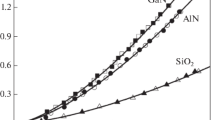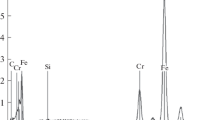Abstract
Carbon-doped oxide SiCOH films with low to ultralow dielectric constants were prepared on a Si substrate by plasma-enhanced chemical vapor deposition (PECVD) from mixtures of SiCOH precursors with organic materials. The films have different levels of nanoscale porosity resulting in different dielectric constants and mechanical properties. The mechanical properties of the films have been characterized by continuous-stiffness nanoindentation measurements. To study the effect of film thickness, each group of samples with the same dielectric constant was composed of samples prepared with different film thicknesses. It is shown that the effective hardness and modulus of the SiCOH/Si substrate system depends significantly on indentation depth due to substrate constraint effects. The “true” film properties were determined using both an empirical formulation of the effective modulus and direct inversion based on a finite element model. The hardness and modulus of three groups of samples with different degrees of dielectric constants have been measured. The hardness increases from 0.7 to 2.7 GPa and modulus from 3.6 to 17.0 GPa as the dielectric constants change from 2.4 to 3.0. While for stiffer films the modulus measured at an indentation depth 10% of the film thickness is close to the “true” value for films thicker than 0.5 µm, the measured value can give an overestimate of up to 35% for softer films. Thin film cracking and film–substrate debonding have been observed with scanning electron and atomic force microscopy at the indentation sites in softer films. The damage initiation is indicated by pop-in events in the loading curve and sharp peaks in the normalized contact stiffness curves versus indentation depth.
Similar content being viewed by others
References
A. Grill: Plasma enhanced chemical vapor deposited SiCOH dielectrics: From low-k to extreme low-k interconnect materials. J. Appl. Phys. 93, 1785 (2003).
A. Grill and D.A. Neumayer: Structure of low dielectric constant to extreme low dielectric constant SiCOH films: Fourier transform infrared spectroscopy characterization. J. Appl. Phys. 94, 1 (2003).
A. Grill and V. Patel: Ultralow-k dielectrics prepared by plasmaenhanced chemical vapor deposition. Appl. Phys. Lett. 79, 803 (2001).
D. Edelstein, C. Davis, L. Clevenger, M. Yoon, A. Cowley, T. Nogami, H. Rathore, B. Agarwala, S. Arai, A. Carbone, K. Chanda, S. Cohen, W. Cote, M. Cullinan, T. Dalton, S. Das, P. Davis, J. Demarest, D. Dunn, C. Dziobkowski, R. Filippi, J. Fitzsimmons, P. Flaitz, S. Gates, J. Gill, A. Grill, D. Hawken, K. Ida, D. Klaus, N. Klymko, M. Lane, S. Lane, J. Lee, W. Landers, W-K. Li, Y-H. Lin, E. Liniger, X-H. Liu, A. Madan, S. Malhotra, J. Martin, S. Molis, C. Muzzy, D. Nguyen, S. Nguyen, M. Ono, C. Parks, D. Questad, D. Restaino, A. Sakamoto, T. Shaw, Y. Shimooka, A. Simon, E. Simonyi, S. Tempest, T. Van Kleeck, S. Vogt, Y-Y. Wang, W. Wille, J. Wright, C-C. Yang, and T. Ivers: Reliability, yield, and performance of a 90 nm SOI/Cu/SiCOH technology, in Proceedings of the IEEE 2004 Intern. Interconnect Technol. Conference, (IEEE, Piscataway, NJ, 2004), pp. 214–216.
A. Grill, V. Patel, K.P. Rodbell, E. Huang, M.R. Baklanov, K.P. Mogilnikov, M. Toney, and H.C. Kim: Porosity in plasma enhanced chemical vapor deposited SiCOH dielectrics: A comparative study. J. Appl. Phys. 94, 3427 (2003).
W.C. Oliver and G.M. Pharr: An improved technique for determining hardness and elastic modulus using load and displacement sensing indentation experiments. J. Mater. Res. 7, 1564 (1992).
W.C. Oliver and G.M. Pharr: Measurement of hardness and elastic modulus by instrumented indentation: Advances in understanding and refinements to methodology. J. Mater. Res. 19, 3 (2004).
X. Li and B. Bhushan: A review of nanoindentation continuous stiffness measurement technique and its applications. Mater. Charact. 48, 11 (2002).
W.D. Nix: Elastic and plastic properties of thin films on substrates: Nanoindentation techniques. Mater. Sci. Eng., A 234, 37 (1997).
R. Saha and W.D. Nix: Effects of the substrate on the determination of thin film mechanical properties by nanoindentation. Acta Mater. 50, 23 (2002).
L. Shen, K. Zeng, Y. Wang, B. Narayanan, and R. Kumar: Determination of the hardness and elastic modulus of low-k thin films and their barrier layer for microelectronic applications. Microelectron. Eng. 70, 115 (2003).
A.A. Volinsky, J.B. Vella, and W.W. Gerberich: Fracture toughness, adhesion and mechanical properties of low-K dielectric thin films measured by nanoindentation. Thin Solid Films 429, 201 (2003).
T.Y. Tsui, C.A. Ross, and G.M. Pharr: A method for making substrate-independent hardness measurements of soft metallic films on hard substrates by nanoindentation. J. Mater. Res. 18, 1383 (2003).
T.Y. Tsui and G.M. Pharr: Substrate effects on nanoindentation mechanical property measurement of soft films on hard substrates. J. Mater. Res. 14, 292 (1998).
R.B. King: Elastic analysis of some punch problems for a layered medium. Int. J. Solids Struct. 23, 1657 (1987).
W.D. Nix and H. Gao: Indentation size effects in crystalline materials: A law for strain gradient plasticity. J. Mech. Phys. Solids 46, 411 (1998).
R. Saha, Z.Y. Xue, Y. Huang, and W.D. Nix: Indentation of a soft metal film on a hard substrate: Strain gradient hardening effects. J. Mech. Phys. Solids 49, 1997 (2001).
Z.H. Xu and D. Rowcliffe: Deriving mechanical properties of soft coatings using nanoindentation: An application of mechanismbased strain gradient plasticity. Surf. Coat. Technol. 157, 231 (2002).
L. Wang and S.I. Rokhlin: Universal scaling functions for continuous stiffness nanoindentation with sharp indenters. Int. J. Solids Struct. 42, 3807 (2005).
L. Wang, M. Ganor, and S.I. Rokhlin: Inverse scaling functions in nanoindentation with sharp indenters: Determination of material properties. J. Mater. Res. 20, 987 (2005).
J.A. Knapp, D.M. Follstaedt, S.M. Myers, J.C. Barbour, and T.A. Friedmann: Finite element modeling of nanoindentation. J. Appl. Phys. 85, 1460 (1999).
A. Grill, D. Edelstein, D. Restaino, M. Lane, S. Gates, E. Liniger, T. Shaw, X-H. Liu, D. Klaus, V. Patel, S. Cohen, E. Simonyi, N. Klymko, S. Lane, K. Ida, S. Vogt, T. Van Kleeck, C. Davis, M. Ono, T. Nogami, and T. Ivers: Optimization of SiCOH dielectrics for integration in a 90 nm CMOS technology, in Proc. IEEE 2004 Int. Interconnect Technol. Conference, (IEEE, Piscataway, NJ, 2004), pp. 54–56.
T.Y. Zhang, W.H. Xu, and M. Zhao: The role of plastic deformation at a rough surface in the size-dependent hardness. Acta Mater. 52, 57 (2004).
S. Qu, Y. Huang, W.D. Nix, H. Jiang, F. Zhang, and K.C. Hwang: Indenter tip radius effect on the Nix-Gao relation in micro- and nanoindentation hardness experiments. J. Mater. Res. 19, 3423 (2004).
J.B. Vella, I.S. Adhihetty, K. Junker, and A.A. Volinsky: Mechanical properties and fracture toughness of organo-silicate glass (OSG) low-k dielectric thin films for microelectronic applications. Int. J. Fracture 119/120, 487 (2003).
D.J. Morris, S.B. Myers, and R.F. Cook: Sharp probes of varying acuity: Instrumented indentation and fracture behavior. J. Mater. Res. 19, 165 (2004).
Y. Toivola, A. Stein, and R.F. Cook: Depth-sensing indentation response of ordered silica foam. J. Mater. Res. 19, 260 (2004).
J.T. Czernuszka and T.F. Page: Characterizing the surface-contact behavior of ceramics. 1. Hardness response of glass-bonded alumina and titania. J. Mater. Sci. 22, 3907 (1987).
M. Hommel and O. Kraft: Deformation behavior of thin copper films on deformable substrates. Acta Mater. 49, 3935 (2001).
B. von Blanckenhagen, P. Gumbsch, and E. Arzt: Dislocation sources and flow stress of polycrystalline thin metal films. Philos. Mag. Lett. 83, 1 (2003).
Author information
Authors and Affiliations
Corresponding author
Rights and permissions
About this article
Cite this article
Wang, L., Ganor, M., Rokhlin, S.I. et al. Nanoindentation analysis of mechanical properties of low to ultralow dielectric constant SiCOH films. Journal of Materials Research 20, 2080–2093 (2005). https://doi.org/10.1557/JMR.2005.0258
Received:
Accepted:
Published:
Issue Date:
DOI: https://doi.org/10.1557/JMR.2005.0258




